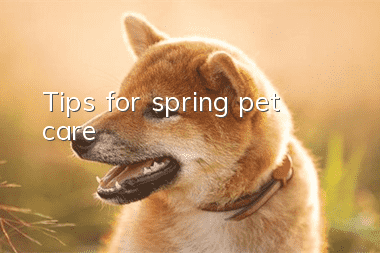Tips for spring pet care

1. Transmission routes of spring diseases
??1. Airborne infection;
In spring, the wind in Beijing is relatively strong, and there is often blowing sand. After a winter of weathering, pet feces becomes drier, while infectious diseases, parasites, and parvovirus can still occur within a year. Contagiousness. Wind can carry animal feces far away, expanding the area of infection for animals.
??2. Direct contact infection;
??Respiratory diseases are the main ones in spring, and they are mainly transmitted through contact between animals, especially puppies. They will lick each other's bodies, which is the most direct route of infection.
??3. Indirect contact infection;
??There is no direct contact with animals, and diseases are spread through people. For example, some people touch the owner’s dog, then touch the west’s dog, and finally touch their own dog, especially children, who do not pay attention to hygiene. Hands have become the most direct route of infection.
2. Common spring diseases and their prevention and treatment
??1. Cough: There are two types of cough. One is caused by cold air irritating the nasal mucosa, causing animals to cough. This kind of cough is not viral, but is caused by dry air. Generally, you can put a humidifier at home. , just keep the moisture in the air, or use some amoxicillin or isatis root. The other type is infectious rhinotracheitis, also called nest cough. This kind of cough is often accompanied by a runny nose and requires treatment at an animal hospital. If the animal only coughs at night, it may be caused by large temperature changes at night. Just pay attention to keeping warm at night.
??2. Vomiting: Cat vomiting may be caused by feline plague or hair vomiting; dog vomiting may be caused by parvovirus or eating too much.
??If it is hair vomiting, just give the animal some dogtail grass or hair vomiting cream, but if it is suspected to be cat distemper or parvovirus, you should go to the pet hospital for treatment in time.
??3. Diarrhea: Dogs are prone to diarrhea. There are usually several situations: ① Overfeeding, animal feces will contain undigested food. Pay attention to the animal's diet, feed less food and drink more water. If the effect is not good, you can try vitamin B. The dog takes one tablet , the cat can eat half a tablet. ② In acute enteritis, animal feces are usually black or dark green. Just take some penicillin and vitamin B complex. ③ If it is caused by an infectious disease, if it is a cat or dog that has not received any vaccination, it is necessary to go to the hospital for testing and then prescribe the right medicine. ④ It is caused by parasites. If the animal’s stool is sometimes dry and sometimes watery, it is time to deworm it.
??4. Excessive eye feces: First, you can check whether there are hairs stuck in the eyes, causing eye irritation. likeIf there are small holes under the eyes, it may have been scratched by a cat or scratched by something. You should go to the hospital for examination and treatment in time. Of course, sometimes getting angry can also cause more eye mucus.
There are many small animal diseases in spring. Please pay attention to your dogs and hope they are healthy.
- Does the dog have to be dried after taking a bath?
- Teach you how to train your Chihuahua to use toilet and toilet, this trick will work!
- Can puppies drink milk powder?
- Bad breath problem in pet dogs
- What dog body language means
- You must know these empirical knowledge to raise a good dog, a collection of common sense about raising a dog!
- Are Greenland dogs smart?
- Learn the following tricks to keep your dog well-trained!
- Why do dogs cough? 5 reasons why dogs cough!
- 6 major misunderstandings about owning a pet dog, are you lying?



